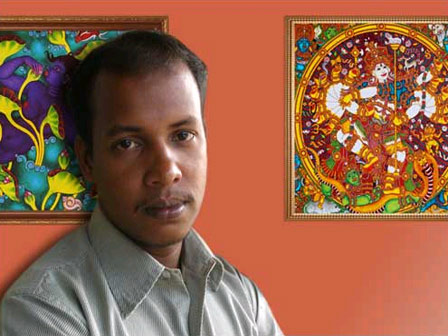
Sasi Edavarad the only artist in his family of five brothers and a sister, has made his family proud. Born in 1976, his commitment to Mural Art began when he was drawn to the temple walls and the intricate paintings as a young child.
It dawned on him when he was only thirteen that the paintings that adorned the temple walls for over 300 years were now fast fading. It worried him that there was no inclination or interest of the young generation to learn the art and keep it alive. He enrolled with the Guruvayur School for Mural Painting, Kerala.
He studied under Guru: 'Master-Artist' Sri K.K. Srinivasan. Sasi Edavarad is a full-time mural artist and has been blessed with the honour of painting the walls of both the famed temples of Kerala; Guruvayur temple and Sree Padmanabhaswamy Temple. A native and resident of Edavarad, a small prestine village, near Perambra in Calicut District. He dedicates his Sundays to teaching young students at Dhyanasankalpam, the Openstudio for Murals, at Calicut and continues to live in his native village Edavarad. He travels extensively on installations across the state and outside of Kerala.
Kerala has a tradition in the field of painting as is evidenced by the murals in temples, palaces and churches. The murals of Tirunandikkara (now in Kanyakumari district) and Tiruvanchikulam are reckoned as the earliest specimens of Kerala painting. These have been assigned to the period from the 9th to the 12th century A.D. Most of the murals now seen in Kerala temples belong to the period from 15th century onwards.One can say that the tradition of painting on walls began in Kerala with the pre-historic rock paintings found in the Anjanad valley of Idukki district. Archaeologists presume that these paintings belong to different periods from upper Paleolithic period to early historic period. Rock engravings dating to the Mesolithic period have also been discovered in two regions of Kerala, at Edakkal in Wayanad and at Perumkadavila in Tiruvananthapuram district.
Archaeological evidences point to the period from the mid-sixteenth century onwards as the most prolific period of mural art of Kerala. Srikumara's Silparatna, a sixteenth century sanskrit text on painting and related subjects must have been enormously useful to contemporary and later artists. This treatise has been acclaimed as a rare work on the techniques of Indian art, the like of which has not been published before or after. It discusses all aspects of painting, aesthetic as well as technical and it is greatly useful in understanding the later medieval murals of Kerala.
The paintings, usually on the walls of the Sanctum sanctorum, depicted deities from the Hindu Pantheon. While the human figures were highly stylized, animals and bird were painted in more naturalistic postures. Such stylized facial expression and gestures trace their origin to the theatrical elements in the performing arts of koodiyattam and Kath kali. Wide-open, round eyes, elongated painted lips, exaggerated eyebrows, dramatic body postures, and over ornamentation are typical of the mural paintings.
Dhyanasankalpam is an Openstudio for Indian (Kerala) murals,and here mural art is regarded as the pursuit of pure aesthetic experience,as Yoga. Its an exalted experience not just for the individual artist but for the whole community and even humanity, that which touches and consorts with every aspect of Indian life.
Dhyanasankalpam creates works that would last a millennium or two if not for posterity, like the murals of Ajanta. All that one has to ensure is that the walls should last just as long. The openstudio is situated at Calicut, Kerala.
For more information and pictures visit
www.dhyanasankalpam.com
Corporate Art Events
Through our unique art events we endeavour to bring together corporates, art and cause for mutual benefit. Our sponsored events align with CSR mandates to support pertinent social causes via art and artists.